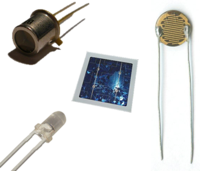
Photo from wikipedia
Sensitive materials in gas sensors sometimes need to be activated at a certain high temperature. High working temperature, however, is one of the main obstacles of fabricating gas sensor. In… Click to show full abstract
Sensitive materials in gas sensors sometimes need to be activated at a certain high temperature. High working temperature, however, is one of the main obstacles of fabricating gas sensor. In this paper, a hydrogen sulfide gas sensor based on cataluminescence at lower temperature than 150 °C was reported. The sensitive material, Pd-doped Fe2O3–Zr4MnO10, was synthesized via precipitation and impregnation. Pd nanoparticles are uniformly distributed on the surface of Fe2O3–Zr4MnO10 with a size of < 50 nm. The working conditions of cataluminescence of hydrogen sulfide on nano-Pd/Fe2O3–Zr4MnO10 optimized by response surface methodology were analytical wavelength of 467.4 nm, reaction temperature of 128.5 °C and carrier gas velocity of 132.8 ml/min. The sensitivity of the method can be increased by 4.5% under the optimized working conditions. The optimization method is universal for many multi-parameter processes. The results indicated that nano-Pd/Fe2O3–Zr4MnO10 could be a good candidate for fabricating hydrogen sulfide gas sensor.
Journal Title: Journal of the Iranian Chemical Society
Year Published: 2020
Link to full text (if available)
Share on Social Media: Sign Up to like & get
recommendations!